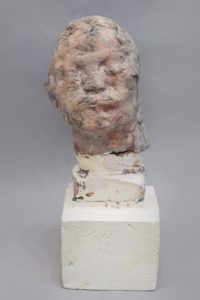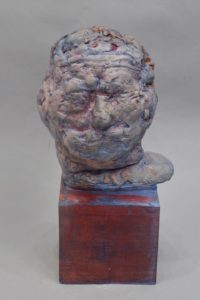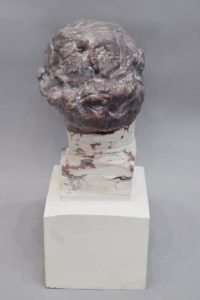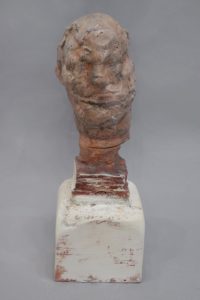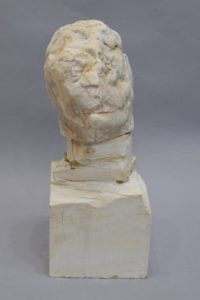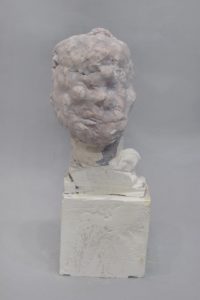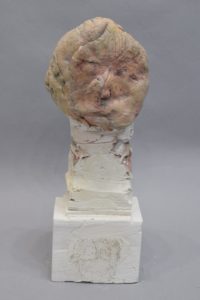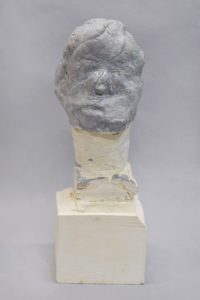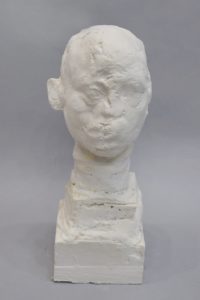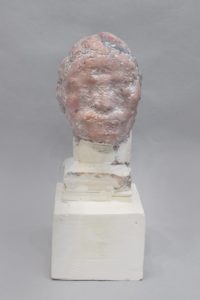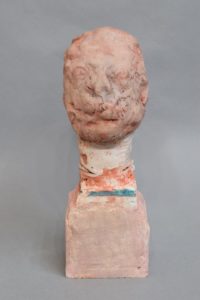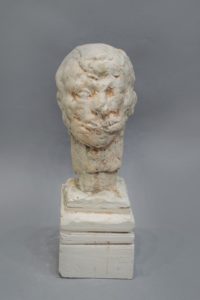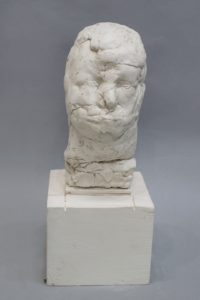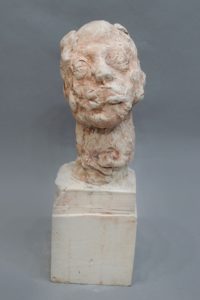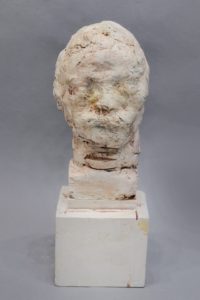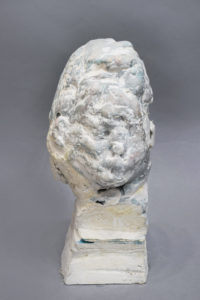Mutable
New Heads by Bruce Gagnier
16 June-30 July 2022
Do not go abroad. Return within yourself. In the inward human being dwells truth. If you find that you are by nature mutable, transcend yourself.
St. Augustine
In his book, Precision and Soul, Robert Musil said, "We do not have too much intellect and too little soul, but too little precision in matters of the soul." Do we agree with what he said? Do we need knowledge of the soul? Do we have too little of it? Do we need precision in recognizing it? These days, as soon as the word, soul or spirituality is dropped in the context of intellectual discussion, one cringes. It is considered to be uncool, first of all, vague, inaccurate, and outdated. It is not useful, and may even be a little harmful to our logical minds to talk about.
The soul, however, is such an interesting concept to think about when we sit down and think about it. In the early ancient Greek culture, the soul meant life, especially when death was suggested; when a person was at risk of losing it, or when they die. Then Greeks started to believe that things that could initiate movement, not just human beings, were "ensouled". Thales thought that even magnets were alive and had souls. And the soul could also refer to the physiological desire to eat ("to satisfy their souls with rich food") or to have sex, and intense emotions like love and hate, joy and grief, and anger and shame. It also meant the moral qualities in a person, like courage, temperance, and justice. When Greeks started to think about the afterlife, they thought that soul was something that would persist after death.
In discussing the immortality of the soul, Plato brought in the concept of movement. He thought that soul was immortal because the soul was always in motion. If something is always moving, it means it is alive. And a soul is a self-mover that doesn't come from anywhere. Instead, it is the origin of other moving things. That is, moving objects moved by a source from the outside have no soul; objects that move from within have a soul. All souls are self-movers so they cannot die.
One of the things Plato added to this discussion was the concept of the imperceptible, which was groundbreaking then. He thought that there were two kinds of existences in the world; the perceptible and the imperceptible. The perceptible is something we can perceive with our senses; the imperceptible we can't. The perceptible consists of physical bodies which can be destroyed or perish. So logically, the imperceptible cannot be destroyed in the same way. The soul belongs to the world of the imperceptible, the invisible, and not-dying.
When something is invisible, it can't be located. But Greeks considered that a soul resides in a body (Soma) and is closely related to the head. A few years ago, Bruce Gagnier started a new painting series that marks a breakthrough for him as an artist. With this new series, he thinks that he might be able to resolve his decades-old problem with abstraction. In this series, a painting looks like both a head and a landscape. It is a head dissipating into a landscape; it is a landscape becoming a head or a soul. He titled, in fact, one of the first paintings of the series, Soul Mountain. He wanted to go straight to the point, I guess. I was the one who suggested a different title being reluctant to use the word soul.
There is a Korean word for soul, 혼백 (魂魄), which normally refers to the "soul after one dies" and is composed of two letters, 혼 (魂) which means the spirit that will rise to heaven (Yang) and 백 (魄) which is in the bones and will be buried in the ground (Ying). Ying and Yang are not two different things, but are in a union, forever in motion, like day and night.
In this show of Gagnier's new heads, each head looks like a soul. It seems to be moving, from within. Bruce Gagnier's sculpture is always in motion. Not a single part of his work stays on the same plane. It refuses to be inanimate. His tactile surface has countless points in space which makes it move, constantly. Living with his work taught me that a good piece of sculpture moves in space, maybe not in time. When I visited the Duomo in Milan, I exchanged text messages with Gagnier, mesmerized by the great many human figure sculptures on its rooftop. When I told him that I was imagining that these figures might be moving around at night when no one's watching, he told me a story. At the Duomo in Sienna, it was late at night when he saw the figures moving as if they were talking to one another.
Susan Sontag defined spirituality in her essay The Aesthetics of Silence as follows; "spirituality: plans, terminologies, ideas of deportment aimed at resolving the painful structural contradictions inherent in the human situation, after human consciousness, at transcendence." I know, it sounds grandiose. But I can’t help but think that this is what (certain) artists do in general when I read it. I am not sure anymore, though, if there will be this kind of artist in the future. What I can say for certain is that Bruce Gagnier never stops working. And that he is in the business of making forms that move from within, portraying something invisible, something that will last. He is the one who knows viscerally and empirically that transcendence is movement.
—Mimi Park
"밖으로 가지 마라. 너 자신에게로 돌아오라. 내면에 진실이 머문다. 네가 본래 변할 수 있다는 것을 안다면, 너 자신을 초월하라."
성 아우구스티누스
로베르트 무질은 그의 책 《정교함과 영혼》에서 "우리가 지식은 너무 많고 영혼이 너무 적은 것이 아니라, 영혼의 문제에 있어 정확하지 않은 것이다."라고 했다. 우리는 그의 이 말에 동의하는가? 영혼에 대한 지식이라는 게 필요한가? 그 지식이 너무 적은가? 영혼을 인식하는 데 정교함이 필요한가? 요즘은 지성적인 논의가 요구되는 맥락에서 영혼, 영성과 같은 단어가 나오면 썰렁해진다. 일단 쿨하지 못하고, 모호하며, 정확하지 않고, 시대에 뒤처진 말을 하는 것 같다. 유용한 개념도 아니고, 심지어 논리적이고 이성적으로 생각하는데 해가 된다고 생각한다.
그런데 영혼이라는 말은 실제로 가만히 앉아서 생각해보면 꽤 흥미로운 개념이다. 고대 그리스 문화에서 영혼은 생명이었다. 그런데 이 말은 주로 죽음이라는 것이 암시될 때 사용되었다. 생명을 잃을 수도 있는 위기에 처한 경우라든지, 실제로 누가 죽었을 때 말이다. 그러고 나서 그리스인들은 스스로 움직일 수 있는 것들에는 영혼이 깃들어 있다고 생각했다. 탈레스는 자석에도 영혼이 있고 생명이 있다고 생각했다. 또한, 영혼은 식욕("기름진 음식으로 그들의 영혼을 만족하게 하다")이나 성욕을 의미하기도 했고, 사랑과 증오, 기쁨과 슬픔, 분노와 수치 같은 강렬한 감정을 말할 때도 사용되었다. 그리고 용기, 절제, 정의와 같은 개인의 도덕적인 품성을 의미할 때도 영혼이란 말을 썼다. 그 후 그리스인들은 사후 세계에 대해 생각하게 되었고, 영혼은 사람이 죽고 몸이 썩은 후에도 남는 어떤 것으로 생각했다.
플라톤은 영혼의 불멸성에 대해 논하기 위해 운동성이라는 개념을 끌어들였다. 그는 영혼이 언제나 움직이기에 불멸성을 가진다고 했다. 뭔가 계속 움직인다면 그건 살아있는 것이다. 그리고 영혼은 스스로 움직이는 것으로 어디에서도 비롯되지 않는다고 생각했다. 대신 영혼은 다른 움직이는 것들의 원천이 된다. 다시 말해, 외부의 요인에 의해 움직이는 것은 영혼이 없다고 할 수 있고, 내부로부터 움직이는 것은 영혼이 있는 것이다. 모든 영혼은 스스로 움직이고 그래서 불멸한다.
플라톤이 영혼의 불멸성을 논하기 위해 제시한 그 논거 중 "지각할 수 없는 세계"(파이돈)의 개념이 있다. 그는 이 세상에 두 종류의 존재가 있다고 했다. 지각할 수 있는 것과 지각할 수 없는 것. 우리의 감각 기관을 통해 지각할 수 있는 것들이 있고, 그렇지 않은 것들이 있다. 보고 만질 수 있는 것은 물리적인 몸체가 있는 것으로 이 몸체는 파괴될 수 있다. 그러니까 논리적으로 몸체가 없는 것은 몸체가 있는 것과 같은 방식으로 파괴될 수 없다. 영혼이라는 것은 지각할 수 없는 세계, 보이지 않는 세계, 죽지 않는 세계에 속하는 것이다.
무언가 보이지 않으면 어디 있는지 알 수 없다. 하지만 그리스인들은 영혼은 몸 안에 있고, 또 머리와 밀접하게 연관된다고 생각했다. 브루스 가니에는 몇 년 전에 새로운 회화 연작을 시작했는데, 작가로서 중요한 돌파였다. 이 연작으로 그는 그가 오랜 세월 가졌던 추상에 대한 문제를 해결할 수 있다고 생각한다. 이 연작에서 그림은 두상 같기도 하고 풍경 같기도 하다. 풍경으로 흩어지는 두상 같기도 하고, 풍경이 두상으로, 영혼으로 되어가는 모습 같기도 하다. 실제로 그는 이 연작 중 초기작들을 〈영혼의 산(Soul Mountain)〉이라고 제목을 지었다. 아마도 바로 본론으로 직진하고 싶어 했던 것 같다. 그때 내가 영혼이란 단어를 제목에 사용하는 것을 주저했었다.
영혼과 유사한 한국어 단어 중 혼백(魂魄)이라는 단어가 있다. 이는 사람이 죽은 후의 혼령이라는 말에 가깝게 쓰이는 말로, 두 개의 글자로 이루어져 있다. 혼(魂)은 사후 하늘로 올라가는 영혼이고, 백(魄)은 뼈 안에 있어 땅에 묻히는 영혼이다. 하늘은 양이고 땅은 음이다. 음과 양은 다른 두 개의 것이 아니라 하나이고, 밤과 낮처럼 영원히 함께 운동하고 있다.
브루스 가니에의 신작 두상들의 전시인 이번 전시에서 두상은 하나의 영혼처럼 느껴진다. 내부로부터 움직이는 영혼말이다. 브루스 가니에의 조각들은 언제나 움직인다. 그의 작품은 어떤 부분도 같은 평면에 머물러있지 않다. 부동의 존재가 되기를 거부한다. 그의 촉각적인 표면은 공간 속에서 셀 수 없는 점들로 구성되어 있고, 그래서 그의 작품은 시시각각 변하는 것이 된다. 그의 조각과 함께 사는 경험을 통해 나는 좋은 조각은 공간 속에서 움직인다는 것을 — 시간 속에서는 아닐지라도 — 배울 수 있었다. 밀라노의 두오모에 갔을 때 나는 그 지붕에 있는 수많은 인체 조각들이 감동한 나머지 조각가인 가니에와 문자를 주고받았다. 내가 이 인체 조각들이 밤에 아무도 안 볼 때 움직일 것 같다고 말했을 때, 그는 이런 이야기를 들려주었다. 그가 시에나에 갔을 때였다. 늦은 밤, 혼자 있었는데, 그곳의 두오모를 나오며 광장에서 문득 위를 올려다보자 그곳에 있는 조각들이 마치 서로 이야기를 주고받듯 움직이는 것을 보았다고 했다.
수전 손택은 《침묵의 미학》이라는 자신의 에세이에서 영성에 대한 정의를 다음과 같이 제공한다. "영성: 인간 존재의 내재한, 고통스러운 구조적인 모순을 해결하고, 인간의 의식을 완성하고, 결국은 초월에 이르는 것을 목표로 한 계획과 용어와 행동과 태도에 대한 생각들." 맞다, 좀 거창하다. 거창하긴 하지만, 결국 이 일이 (어떤) 예술가들이 하는 일이 아닌가 하는 생각이 드는 것이 사실이다. 물론 앞으로도 예술가들이 이 일을 할지, 그건 잘 모르겠다. 내가 말할 수 있는 것은 브루스 가니에가 멈추지 않고 일하는 예술가라는 사실이다. 그는 내부로부터 움직이는 형태를 만들고, 보이지 않는 것의 초상을 만들고, 앞으로도 쉽게 사라지지 않을 뭔가를 만드는 일을 하고 있다. 그는 초월이 움직임이라는 것을 직관적으로, 경험적으로 알고 있는 사람이다.
—박상미
